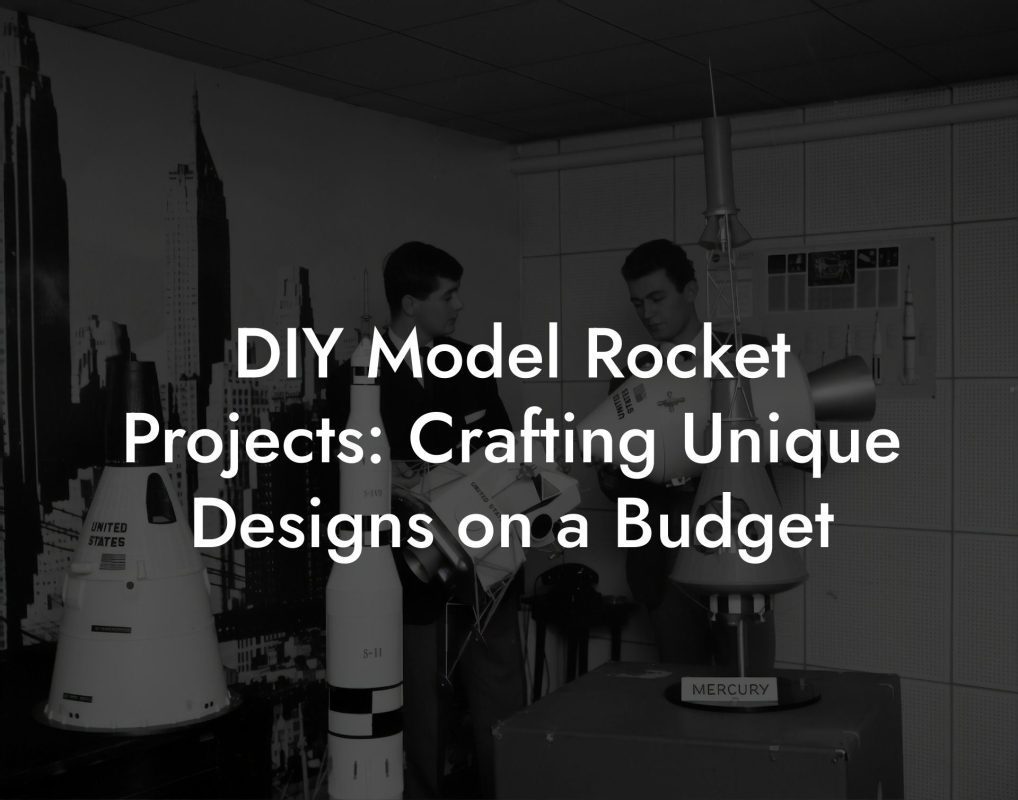In an era where sustainability matters more than ever, model rocketry is embracing eco-friendly practices that make each launch not only exciting but also environmentally responsible. "Upcycling and Recycling: Sustainable Practices in Model Rocketry" explores innovative ways to repurpose materials, reduce waste, and create high-performance rockets while protecting our planet. Whether you're a seasoned rocketeer or a beginner eager to make a difference, this guide offers practical tips, creative ideas, and inspiring projects that prove sustainable rocketry is the future.
Quick Links to Useful Sections
- Introduction: Sustainability Takes Flight
- Why Sustainability in Model Rocketry Matters
- Upcycling in Model Rocketry
- Creative Upcycling Ideas
- Recycling Materials for Model Rocketry
- Recycled Materials in Practice
- Sustainable Practices in Model Rocket Design
- Eco-Friendly Adhesives and Finishes
- Energy-Efficient Production
- Modular and Repairable Designs
- DIY Projects and Tutorials for Sustainable Rocketry
- Featured DIY Projects
- Model Rocketry FAQs: Sustainability and Eco-Friendly Practices
- Your Next Launch: Build Green, Fly High, and Inspire Change
Introduction: Sustainability Takes Flight
Traditional model rocketry often relies on new, specialized materials and components that can be costly and resource-intensive. However, the growing movement towards sustainability has sparked a wave of innovative practices in the hobby. From upcycling everyday materials to recycling components from previous projects, eco-conscious rocketeers are finding creative ways to minimize waste and reduce their environmental footprint.
This guide dives into sustainable practices in model rocketry, showing you how to transform discarded items into vital rocket components, repurpose used materials, and implement eco-friendly techniques that maintain high performance without compromising our planet’s resources.
Why Sustainability in Model Rocketry Matters
Sustainability in model rocketry is more than a trend, it's a commitment to reducing waste, conserving resources, and inspiring future generations to think green. By integrating sustainable practices, you not only lower your environmental impact but also challenge yourself to innovate creatively.
Key benefits of sustainable rocketry include:
Looking For The Best Model Rocket Kits? You'll Love These:
- Resource Conservation: Upcycling and recycling reduce the need for new raw materials, lowering costs and environmental impact.
- Innovation: Creative reuse of materials sparks new design ideas and engineering solutions.
- Community Impact: Sustainable practices inspire fellow enthusiasts and promote environmental awareness within the rocketry community.
- Cost Savings: Utilizing recycled and upcycled materials can significantly reduce the overall cost of projects.
Upcycling in Model Rocketry
Upcycling involves transforming waste materials or discarded objects into products of higher value. In model rocketry, this can mean repurposing items that would otherwise end up in a landfill into essential rocket components.
Creative Upcycling Ideas
Here are some innovative upcycling projects to consider:
- Plastic Bottles: Use empty, clean plastic bottles as body tubes or payload compartments. With some cutting, sanding, and painting, these everyday items can form the backbone of your rocket.
- Aluminum Cans: Recycle aluminum from soda cans to create engine casings or decorative elements. Aluminum’s lightweight and durable properties make it an excellent material for small structural components.
- Cardboard Tubes: Repurpose cardboard tubes from paper towels or wrapping paper to serve as structural supports or fin molds. Reinforce them with eco-friendly adhesives to boost durability.
- Old Electronics: Salvage components from outdated gadgets for onboard sensors, LED lighting, or even as parts of a DIY telemetry system. This not only recycles waste but also adds a technological edge to your rocket.
Upcycling not only minimizes waste but also encourages a hands-on, resourceful approach to design, turning what might be considered trash into treasure.
Recycling Materials for Model Rocketry
Recycling involves processing used materials to make them suitable for reuse. Many rocketeers have discovered that everyday recycled materials can be excellent alternatives to traditional components.
Recycled Materials in Practice
Consider these practical recycling ideas:
- Recycled Paper and Cardboard: Use recycled paper to form paper mache rocket bodies or fins. With proper reinforcement, these materials can be both lightweight and surprisingly durable.
- Scrap Wood: Salvage offcuts of balsa or other lightweight woods from local hardware stores or community workshops to build fins or structural supports.
- Used Plastics: Collect and repurpose various types of plastics, from polyethylene to PET, to create custom body tubes and components. Many plastics can be easily cut, shaped, and sealed for improved performance.
- Metal Scraps: Small pieces of metal, such as tin or aluminum, can be fashioned into small brackets, clamps, or even decorative accents that enhance both the functionality and aesthetic of your rocket.
Recycling not only benefits the environment by reducing waste but also adds an element of creativity, as you experiment with materials that are both unconventional and sustainable.
Sustainable Practices in Model Rocket Design
Beyond material choices, sustainable practices extend to every stage of the design and construction process. Here are several strategies to embrace:
Eco-Friendly Adhesives and Finishes
Use water-based, non-toxic adhesives and eco-friendly paints that reduce harmful volatile organic compounds (VOCs). These products are safer for you and better for the environment, without sacrificing the strength and durability needed for rocketry.
Energy-Efficient Production
Consider the energy consumption of your production process. If possible, use hand tools and manual methods instead of power tools to reduce your energy footprint, and recycle waste materials generated during construction.
Modular and Repairable Designs
Design your rockets with repair and upgrade in mind. A modular design not only allows you to easily replace worn components but also extends the life of your rocket by minimizing complete rebuilds.
By integrating sustainable practices throughout the design process, you create a model rocket that is as kind to the environment as it is high-performing.
DIY Projects and Tutorials for Sustainable Rocketry
There are numerous resources available to help you get started with sustainable rocketry. Online forums, video tutorials, and community workshops offer step-by-step guides and inspiration for eco-friendly projects.
Featured DIY Projects
- Upcycled Plastic Bottle Rockets: Learn how to convert recycled plastic bottles into lightweight, durable rocket bodies.
- Paper Mache Fins: A tutorial on creating strong, aerodynamic fins using recycled paper and eco-friendly glue.
- Recycled Wood Structural Supports: Tips for using scrap wood to reinforce your rocket’s structure without adding unnecessary weight.
- Eco-Friendly Paint Techniques: Master the art of using water-based paints and natural dyes to achieve vibrant, professional finishes.
These projects not only teach you valuable skills but also demonstrate that sustainable rocketry can be both innovative and budget-friendly.
Model Rocketry FAQs: Sustainability and Eco-Friendly Practices
Here are some frequently asked questions to guide your journey into sustainable model rocketry:
1. Why is sustainability important in model rocketry?
Embracing sustainability helps reduce environmental impact, conserves resources, and encourages innovation and resourcefulness in rocketry.
2. What are some common materials used in upcycled rockets?
Materials such as plastic bottles, recycled paper and cardboard, scrap wood, and metal remnants can be repurposed to create various rocket components.
3. How can I ensure that recycled materials are safe and reliable for rocket construction?
Thoroughly inspect and, if necessary, treat recycled materials to ensure they meet the structural and performance requirements of your design.
4. Are eco-friendly adhesives and paints as effective as conventional ones?
Yes, many eco-friendly adhesives and water-based paints offer comparable performance while reducing toxic emissions and environmental harm.
5. What are the benefits of modular designs in sustainable rocketry?
Modular designs allow for easier repairs and upgrades, reducing waste by extending the life of your rocket through component replacement rather than complete rebuilds.
6. How can I reduce waste during the rocket building process?
Plan your projects carefully to minimize off-cuts, repurpose leftover materials, and recycle scrap components whenever possible.
7. What tools are recommended for DIY sustainable rocketry projects?
Basic hand tools, precision cutting instruments, and eco-friendly adhesives and finishes are essential for creating durable and sustainable rockets.
8. How do I balance cost and sustainability in my projects?
Look for recycled and upcycled materials, leverage community resources, and invest in key performance areas while using affordable alternatives for non-critical components.
9. Can sustainable practices improve the performance of my rocket?
Absolutely. Lighter, repurposed materials can reduce overall weight, and modular, repairable designs lead to better maintenance and performance over time.
10. Where can I find more resources on sustainable model rocketry?
Explore online forums, eco-friendly DIY blogs, rocketry clubs, and community workshops dedicated to sustainable practices and creative upcycling projects.
Your Next Launch: Build Green, Fly High, and Inspire Change
Embracing upcycling and recycling in model rocketry not only leads to creative and unique designs but also champions environmental sustainability. By transforming everyday materials into functional rocket components, you reduce waste, lower costs, and set an inspiring example for others in the community.
So, gather your recycled materials, unleash your creativity, and build a rocket that soars both in the sky and in the hearts of those who care about our planet. The future of rocketry is green, and it’s time for you to lead the way.
Looking For The Best Model Rocket Kits? You'll Love These:
Useful Interruption: Dive deeper into the world of Model Rockets with our most popular sections. If there is anything you think is missing or anything you would love for us to write about, just give us a shout.
- Getting Started & Basics With Model Rockets
- Model Rocket Design, Build & Customization
- Model Rocket Propulsion & Engine Technology
- Model Rocket Launch Techniques & Recovery
- Model Rocket Advanced Rocketry & Innovations
- Model Rocket DIY and Customization
- Model Rocket Equipment Reviews & Digital Tools
- Community, Competitions & Education
- Model Rocket Troubleshooting & FAQs
- Model Rocket Bonus/Seasonal & Niche Topics
A group of model rocket enthusiasts gathered at a field for their weekly launch event. Among them was Dave, a seasoned builder known for pushing the limits of hobby rocketry. This time, he had outdone himself.
“Ladies and gentlemen,” Dave announced, dramatically pulling a cloth off his latest creation, “I present to you: The Kraken!”
The crowd gasped. This wasn’t just a model rocket, it was a monster. The thing stood 8 feet tall, had six clustered engines, and was covered in enough duct tape to qualify as a classified aerospace project.
“Dave,” muttered Steve, the cautious safety officer, “Have you, uh… done the math on this?”
“Math?” Dave scoffed. “I built it in my garage at 3 a.m. with parts from eBay. This is an art piece, Steve.”
The countdown began.
5…
4…
3…
2…
1…
The engines ignited with a BOOM, and The Kraken shot up… kind of. It immediately did a violent barrel roll, narrowly missing the spectators before skyrocketing at an angle that could only be described as “legally questionable.”
The crowd collectively ducked as The Kraken flew straight over the adjacent cornfield, where Old Man Jenkins, the grumpiest farmer in town, was minding his business.
KABOOM!
The rocket disappeared behind the barn. A moment later, a flaming piece of Estes igniter wire landed at Steve’s feet. The silence was deafening.
And then, an unmistakable sound echoed across the field.
Jenkins’ shotgun being cocked.
“DAVE!!!” Steve shouted. “RUN.”
And that was the day Dave invented the first-ever biologically powered rocket booster: pure adrenaline.
To this day, nobody knows where The Kraken landed, but legend has it, it still haunts the skies, terrifying unsuspecting drones and low-flying birds.






